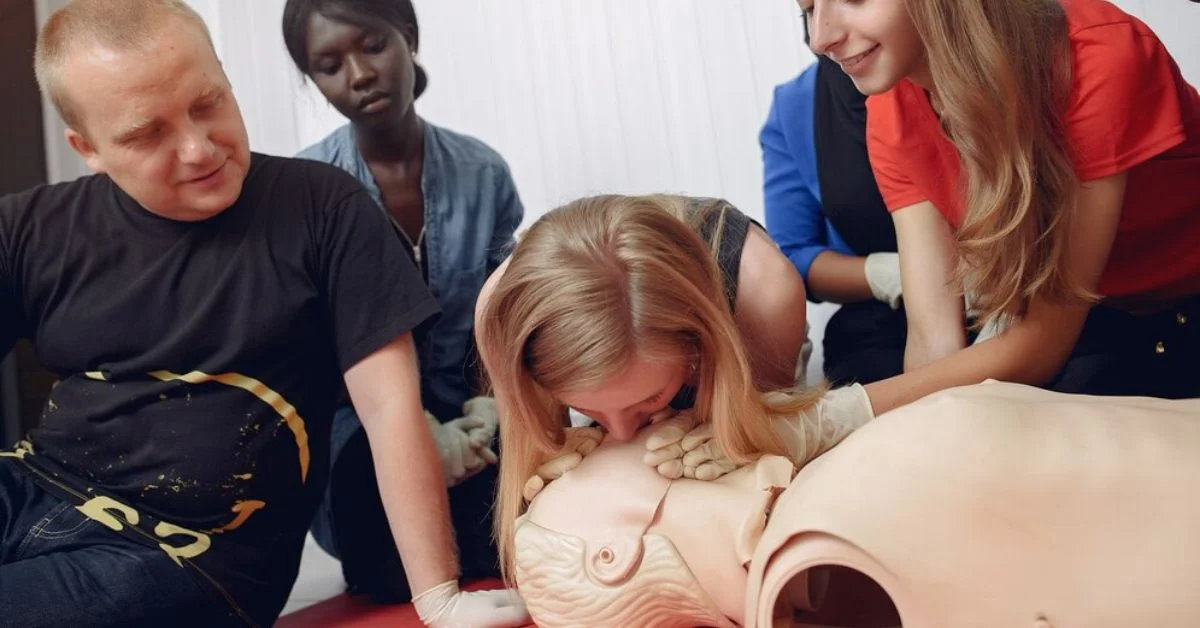EDUCATION
Mastering Pediatric Airway Management in ACLS: Essential Techniques for Successful Resuscitations

When we talk of emergency medicine, the most important aspect is the careful handling of pediatric airway management. Think of a scenario where swift and quick intervention is imperative to safeguard the very fragile lives of young patients. It is within this context that the mastery of pediatric airway management techniques emerges as an indispensable skill.
Guided by the principles of Pediatric Advanced Life Support (PALS), through this blog we will be on a journey of proficiency and compassion. We will be recognizing each acquired technique as a potent tool for ensuring successful resuscitations. Embracing this very ethos, we navigate the realm of pediatric care with unwavering dedication for the best patient outcomes
1. Why is Pediatric Airway Management Crucial in ACLS Resuscitations?
Pediatric airway management stands as a key aspect of ACLS resuscitations. Understanding the critical importance of securing and maintaining a patent airway in pediatric emergencies is imperative for successful resuscitation efforts.
Unique Anatomy and Physiology:
Children possess anatomical and physiological differences in their airways compared to adults so this makes it important for effective management, challenging yet imperative during resuscitations. Factors such as a relatively larger tongue, narrower airway diameter, and higher propensity for obstruction require much more specialized approaches in pediatric airway management.
Susceptibility to Hypoxia:
Many pediatric patients are highly susceptible to hypoxia due to their higher metabolic rates and lower functional residual capacities. So any kind of compromise in airway patency can rapidly lead to profound hypoxemia. This then exacerbates the underlying pathology and even compromises organ function. Thus, ensuring adequate oxygenation through proper airway management is critical for better outcomes in pediatric resuscitations.
Potential for Rapid Clinical Deterioration:
Pediatric patients who experience respiratory distress or failure can deteriorate rapidly. This is because compromised airways are a common factor. Without a prompt and effective intervention to secure the airway, such patients are at bigger risk of progressing to respiratory arrest or cardiac arrest. Therefore, proactive and skillful management of the pediatric airway is essential to prevent further deterioration and allow for successful resuscitation efforts.
2. What are the Key Techniques for Effectively Managing Pediatric Airways in ACLS?
The key techniques for managing pediatric airways are essential for ensuring successful outcomes. With their unique anatomical and physiological differences, pediatric patients require specialized approaches to airway management. Let’s read on to know more
Proper Positioning:
Correct positioning of the pediatric patient is so important to maintaining airway patency and allowing effective ventilation. Techniques such as the head-tilt/chin-lift maneuver or the modified jaw thrust maneuver can help align the airway and prevent obstruction. This is particularly for children with potential cervical spine injuries.
Size-Appropriate Airway Devices:
Selecting and utilizing size-appropriate airway devices is of primary importance in pediatric airway management. Techniques such as selecting the correct size of oropharyngeal or nasopharyngeal airways, and also appropriately sized endotracheal tubes or supraglottic airway devices, lead to proper fit and reduce the risk of airway trauma or obstruction.
Bag-Mask Ventilation:
Then comes the bag-mask ventilation remains a fundamental technique in pediatric airway management.In specific situations where advanced airway interventions are not immediately available or indicated. Proper technique that includes maintaining a good mask seal and delivering appropriate tidal volumes, is crucial for effective ventilation and oxygenation in pediatric patients.
3. What Considerations Should Healthcare Providers Keep in Mind for Successful Pediatric Resuscitations?
Successful pediatric resuscitations need healthcare providers to navigate unique considerations that are specific to the pediatric population. Understanding and addressing these considerations are essential for optimizing outcomes and ensuring that the best possible care that can be given to pediatric patients .
Age-Appropriate Assessment:
Healthcare providers have to adjust and tailor their assessment approach to the age and developmental stage of the pediatric patient. This includes considering differences in vital signs, anatomical features, and communication abilities all among infants, toddlers, school-age children, and also adolescents.
Emotional Support for Parents and Caregivers:
Pediatric resuscitations can be emotionally very distressing for parents and caregivers who are witnessing their child in a critical condition. Healthcare providers must offer empathetic support, clear communication, and reassurance to help alleviate anxiety and encourage more collaboration in decision-making during resuscitative efforts.
Conclusion
In conclusion, navigating the complexities of pediatric resuscitations needs a very holistic approach that includes not only clinical expertise but also compassion and sensitivity to the unique needs of pediatric patients and their families. So, by keeping considerations such as age-appropriate assessment, emotional support for parents, and pediatric-specific equipment in mind, healthcare providers can enhance their ability to deliver successful resuscitations. Also, through ongoing training and proficiency in pediatric advanced life support, healthcare teams stand strong to provide the highest standard of care to ensure best possible outcomes for patients in the pediatric segment.
LAW
What to Expect When Working with a Charlotte Bicycle Accident Lawyer on Your Claim

Bicycle accidents can be overwhelming and leave people feeling unsure about what steps to take next. Whether you were riding to work, exercising, or simply enjoying a weekend ride, a sudden crash can turn your life upside down. Physical injuries, medical expenses, and loss of income often create stress that can feel difficult to manage. This is when having a supportive advocate on your side becomes incredibly important. A Charlotte bicycle accident lawyer can help you understand your rights and guide you through the legal process while you focus on recovery.
After a serious accident, it’s normal to have questions about who is responsible for your damages, how your medical bills will be paid, or how you can recover compensation for time missed from work. Even a seemingly minor injury can become costly if it leads to ongoing care or complications later. By reaching out to a trusted Bicycle Accident Law Firm in North Carolina, victims can get clear answers and feel more confident in their decisions. This type of guidance can relieve some of the burden that often follows a crash and help you move forward.
Choosing an experienced bicycle accident law firm in Charlotte, NC who understands local laws can make a meaningful difference in how smoothly your claim progresses. Rosensteel Fleishman Car Accident & Injury Lawyers in Charlotte has built a reputation for focusing on personal injury and car accident cases with a personal, client-centered approach. If you’ve been hurt, contacting a Bicycle Accident Attorney Near Me is a smart way to ensure that you’re not handling the complexities of insurance companies and legal claims on your own. The team at Rosensteel Fleishman is available at 1-704-714-1450 for a free consultation to help you begin the process with confidence.
Unlock deeper insights – check out this related post you shouldn’t miss!
Understanding What a Charlotte Bicycle Accident Lawyer Can Do For You
Working with a Charlotte bicycle accident lawyer provides more than just legal representation. It gives you access to someone who understands how collisions involving cyclists are investigated, documented, and resolved in North Carolina. This knowledge is valuable because bicycle accidents often involve unique circumstances, such as shared road rules with vehicles, local ordinances, and issues like visibility or driver negligence. A professional attorney can assess the details of your case, explain your options, and guide you through each step so you do not feel alone.
One of the most important roles of a lawyer in this situation is to handle communication with insurance companies. After an accident, you may receive calls or letters asking for statements or pushing for quick settlements. Without guidance, it can be easy to accept an offer that doesn’t fully cover your expenses. An attorney experienced in bicycle accident claims will negotiate on your behalf to seek fair compensation for medical bills, lost wages, pain, and other damages. This allows you to focus on your recovery instead of paperwork and deadlines.
In addition to negotiating settlements, a Bicycle Accident Attorney in Charlotte, NC can represent you in court if necessary. While many claims are resolved without a trial, having an attorney prepared to litigate strengthens your case and signals to insurers that you are serious about obtaining fair compensation. This comprehensive support helps level the playing field between accident victims and large insurance companies, which often have teams of lawyers protecting their own interests.
Key Areas Where a Lawyer Provides Support
An attorney can assist with several critical aspects of your case, including gathering evidence such as police reports and witness statements, coordinating with medical professionals to document injuries, calculating damages for current and future expenses, and identifying any additional liable parties such as contractors or municipalities responsible for unsafe road conditions. By handling these details, your lawyer helps create a strong foundation for your claim, which can improve the chances of a favorable outcome.
How a Bicycle Accident Law Firm in North Carolina Helps Protect Your Rights
When you work with a local Bicycle Accident Law Firm in North Carolina, you gain the advantage of attorneys familiar with state laws, local court systems, and the expectations of insurance adjusters. This local insight allows them to anticipate challenges and better position your claim for success. They know the common tactics used to minimize payouts and can respond quickly and effectively to protect your rights.
Rosensteel Fleishman Car Accident & Injury Lawyers is based in Charlotte and has extensive experience focusing on personal injury and car accident cases. This means they understand how to approach bicycle accident claims from start to finish, providing steady guidance while keeping you informed at every stage. Their client-centered approach aims to reduce stress and give you the clarity you need to make informed decisions.
Working with a Bicycle Accident Attorney Near Me also offers practical benefits. It allows for easier communication, in-person meetings, and faster response times to urgent matters. You don’t have to feel like just another case file. Instead, you receive personal attention from attorneys who understand the specific challenges faced by accident victims in your area.
Why Local Representation Matters
Hiring a local attorney means your case is handled by someone who knows the roads, intersections, and traffic patterns where your accident happened. This familiarity can be helpful when investigating the circumstances of your crash or challenging inaccurate claims from opposing parties. It also means the attorney can bring in local experts or witnesses to strengthen your case.
The Advantages Of Hiring Rosensteel Fleishman Car Accident & Injury Lawyers
Choosing Rosensteel Fleishman after a bicycle accident gives you access to a team focused on providing reliable, experienced legal support to injury victims in Charlotte. The firm’s attorneys, Corey Rosensteel and Matthew Fleishman, understand the emotional and financial toll that accidents can take on individuals and families. They work to ensure clients feel informed and supported throughout the claims process, not overwhelmed by it.
Their dedication shows in the way they approach each case. Rather than offering generic solutions, they take time to understand your unique situation and tailor their guidance to your needs. This approach can help uncover damages you may not have considered, such as future medical care, loss of earning capacity, or emotional distress. By identifying all possible avenues for compensation, Rosensteel Fleishman strives to maximize the value of your claim.
Clients also benefit from the firm’s hands-on involvement. Instead of passing your case off to junior staff, you can expect direct interaction with experienced attorneys who know how to handle complex accident cases. This level of involvement can provide peace of mind, especially during a difficult recovery period when having a reliable advocate matters most.
Compassionate Support With A Focus On Results
At Rosensteel Fleishman, you’ll find a balance of professionalism and compassion. The attorneys are committed to listening to your concerns, answering your questions, and keeping you updated about your case. They understand that every client’s situation is different, and they approach each one with care and attention to detail.
Getting The Help You Need After A Bicycle Accident In Charlotte
Recovering from a bicycle accident can be a long process, but you don’t have to do it alone. Working with an experienced Charlotte lawyer who focuses on bicycle accident claims can give you the confidence and clarity you need to move forward. By partnering with a firm like Rosensteel Fleishman Car Accident & Injury Lawyers, you gain a reliable advocate who will work to protect your rights and pursue the compensation you deserve.
If you or someone you love has been injured in a bicycle accident, it’s important to seek legal guidance as soon as possible. Delays can make it harder to collect evidence, identify witnesses, or file your claim on time. Taking action early ensures that your case is positioned for the best possible outcome.
Our Law Firm’s Charlotte Office Location
As Corey Rosensteel often says, “Our goal is to take the stress off your shoulders so you can focus on your recovery while we focus on your case.” This client-first philosophy underscores the firm’s commitment to providing effective, compassionate legal support to accident victims throughout Charlotte and North Carolina.
Start Your Free Consultation With Rosensteel Fleishman Car Accident & Injury Lawyers Today
You can begin protecting your rights and exploring your legal options with a simple phone call. Contact Rosensteel Fleishman Car Accident & Injury Lawyers at 1-704-714-1450 for a free consultation. Their experienced team is ready to listen, provide clear answers, and help you move forward after a bicycle accident. Taking this step can provide peace of mind and ensure you’re not facing the challenges of a legal claim alone.
Spotlight read: Our featured post delivers key insights worth your time.
LAW
Why Working with a Workers Compensation Benefits Lawyer in Charlotte Can Help You Secure Fair Coverage

It’s easy to feel overwhelmed when you’re hurt on the job and unsure how to keep your finances afloat. You may have medical bills piling up, missed paychecks, and questions about how to get the help you need. If you’re like many workers in Charlotte, the thought of filing for workers’ compensation might seem like just another stressor on your plate. The process can be confusing, and it’s not always clear what benefits you’re entitled to or how to make sure you actually receive them.
That’s where working with a workers compensation benefits lawyer in Charlotte can make a real difference. You shouldn’t have to navigate this process alone, especially when your health and financial security are on the line. A lawyer who understands the local system can help ensure you’re not missing out on benefits or getting buried in paperwork. Whether your injury was sudden or developed over time, getting solid legal guidance from someone who focuses on helping injured workers puts you in a stronger position to move forward.
Rosensteel Fleishman Car Accident & Injury Lawyers has been a trusted name for individuals in Charlotte who need legal support after an accident or workplace injury. Speaking with a Charlotte lawyer who is familiar with workers’ comp claims can help take some of that weight off your shoulders. If you’re unsure where to start or have been denied benefits, calling the firm for a free consultation might be the step you need to secure the coverage you deserve.
Dive deeper with this related read – it’s packed with insights you’ll value!
Understanding Workers’ Compensation Benefits in Charlotte
Workers’ compensation is a type of insurance designed to provide support when you’re injured on the job. It exists to cover lost wages, medical expenses, and in some cases, rehabilitation or disability benefits. In North Carolina, employers are generally required to carry this insurance to protect their employees. But just because coverage exists doesn’t mean accessing it is simple.
One common issue injured workers face is understanding which benefits they qualify for and how to properly file a claim. While the system is meant to be supportive, many people find it frustrating to deal with delays, denials, or lack of communication. That’s why having a Charlotte workers compensation lawyer by your side can be valuable. A knowledgeable legal team can guide you through what documentation is needed, when deadlines apply, and how to respond if the insurance company disputes your claim.
You also want to make sure that the benefits you receive accurately reflect the severity of your injury. If you’re unable to return to work for an extended period—or ever—you may be entitled to more than basic coverage. Having a workers compensation lawyer in Charlotte to evaluate your case can ensure your needs are fully addressed.
Common Challenges Workers Face When Filing Claims
Even though the law is intended to protect employees, insurance companies may not always act in your best interest. It’s not uncommon for a valid claim to be delayed or denied due to paperwork errors, missed deadlines, or lack of medical evidence. In other cases, employers might dispute that an injury happened at work or argue that it’s not as serious as reported.
Another challenge workers face is pressure to return to work before they’re medically ready. When your health is on the line, these decisions should be made with your doctor—not your employer’s insurance company. A workers compensation attorney in Charlotte, NC can advocate for your rights and ensure that you’re not being rushed through the process unfairly.
There’s also the issue of knowing what to do if you’re already receiving partial benefits, but still not able to work at full capacity. You may have more options than you realize. Legal guidance helps you explore all avenues of support, including vocational rehabilitation or additional compensation.
Why Local Legal Support Matters After a Workplace Injury
Choosing a Charlotte injury law firm means working with professionals who understand the ins and outs of North Carolina’s workers’ compensation laws. Local experience can make all the difference in how smoothly your case proceeds. These attorneys are familiar with regional claim trends, local medical providers, and the habits of area insurance adjusters.
Working with someone nearby also makes communication easier. You’re not calling a firm across the state or waiting days for a response. A local workers compensation law firm can provide in-person support if needed and help you build a stronger case through timely, accurate documentation. This level of connection and accessibility can reduce stress and improve your chances of a fair outcome.
If your injury was serious, involved long-term disability, or you’re unsure about the strength of your claim, turning to a workers compensation lawyer near me is a smart move. Their job is to make sure you understand your rights and that the insurance process doesn’t leave you behind.
The Value of Personal Attention in a Legal Case
Every workers’ comp claim is different. Some involve temporary injuries with a clear recovery timeline, while others deal with chronic conditions or permanent disability. A reliable Charlotte workers compensation lawyer will treat your case as unique, not just another file in the system.
They take the time to listen to what happened, review your medical records, and explain your options clearly. You’re not expected to be an expert in legal procedures—that’s their role. With legal support tailored to your situation, you have a much better chance of getting the benefits you’re truly entitled to under North Carolina law.
That kind of attention can also help ease the emotional toll that comes with being injured and uncertain about your future. It’s about more than just paperwork—it’s about feeling heard and respected during a tough time.
How Rosensteel Fleishman Supports Injured Workers in Charlotte
Rosensteel Fleishman Car Accident & Injury Lawyers has built its reputation by consistently providing reliable, personalized legal support to injured workers throughout Charlotte and across North Carolina. The firm understands that being hurt on the job can be one of the most stressful experiences someone goes through. That’s why they take every case seriously, offering thoughtful legal advice and a steady hand throughout the process.
When you work with Rosensteel Fleishman, you’re not passed from person to person. Instead, you get to speak directly with experienced attorneys like Corey Rosensteel and Matthew Fleishman who have helped many clients successfully pursue workers’ compensation claims. They know the law, but more importantly, they understand the people they serve.
What sets them apart is their focus on the individual. Whether your injury involved a fall, machinery accident, repetitive stress, or another workplace hazard, the team at Rosensteel Fleishman works hard to ensure every detail is addressed. They walk clients through each stage of the process—handling filings, communicating with insurers, and preparing for hearings if needed—all while keeping the client informed and in control.
Accessible, Compassionate Legal Support for Every Client
People often hesitate to contact a lawyer because they worry about cost or feel unsure about whether their case is “serious enough.” At Rosensteel Fleishman, consultations are free, and there’s no obligation to move forward. This allows injured workers to get answers and feel empowered before making any decisions.
The team believes that everyone deserves access to high-quality legal representation, regardless of income or background. This commitment is evident in the way they treat every client—with honesty, patience, and respect. If your injury has made it hard to work or manage your life as usual, talking to a personal injury attorney with local experience can help clarify what’s next and how to protect your rights.
Their long-standing presence in Charlotte gives them unique insight into the local court system, medical network, and insurance practices. It’s this blend of legal knowledge and community awareness that helps clients feel more confident about their case and more hopeful about their recovery.
Get Legal Help When It Matters Most in Charlotte
When you’re recovering from a workplace injury, the last thing you want is to feel alone or confused about your rights. Working with a Charlotte-based law firm like Rosensteel Fleishman means you’ll have experienced legal support that is both knowledgeable and approachable. They’ve helped countless injured workers secure the benefits they need to heal and move forward.
Our Law Firm’s Charlotte Office Location
Whether your injury just occurred or your claim has already been denied, it’s not too late to get help. As Corey Rosensteel explains, “We believe that injured workers deserve to understand their rights and be treated with dignity. We’re here to guide them through the process every step of the way.”
To find out what your options are, schedule a free consultation with Rosensteel Fleishman Car Accident & Injury Lawyers by calling 1-704-714-1450. It’s a simple step that can make a big difference in your recovery and your future.
Start Your Free Consultation With a Charlotte Workers Compensation Lawyer Today
Don’t wait for the insurance company to decide what your recovery looks like. If you’ve been injured at work in Charlotte, speak with Rosensteel Fleishman and find out what support you’re entitled to. From securing lost wages to making sure your medical care is fully covered, their team is ready to help. Call 1-704-714-1450 now for a free consultation and get answers tailored to your situation.
Spotlight on this featured post – a must-read with key takeaways inside.
EDUCATION
5 Easy At-Home Learning Activities to Support Your Preschooler’s Growth

Preschool years are some of the most important for a child’s development. From language to motor skills, from emotional awareness to problem-solving, these early years lay the foundation for future learning. While preschools provide structured learning, what you do at home can make a huge difference too.
The good news? Supporting your child’s growth doesn’t mean creating a classroom at home. It’s about simple, playful activities that encourage exploration, curiosity, and confidence.
Here are five easy at-home learning activities that help build essential skills and make learning fun for both you and your preschooler.
Curious for more? This related post dives deeper into what matters most to you.
Learning Activities to Support Your Little One’s Preschool Learning
- Story Time with a Twist
Reading is one of the most powerful learning tools for young children. But instead of just reading stories to your child, try making story time more interactive.
Try This:
- Let your child “read” the pictures and guess what happens next.
- Pause and ask, “What would you do if you were in this story?”
- After reading, act out parts of the story with toys or even dress-up.
Skills developed: Language, comprehension, imagination, and empathy.
Reading regularly also builds focus and listening skills, which are especially helpful for children preparing for preschool admission and adjusting to group learning environments.
- Shape Hunt Around the House
Turn your home into a playful classroom with a simple shape hunt game. It’s an engaging way to introduce early math and observation skills.
Try This:
- Ask your child to find objects in different shapes: circles, squares, and triangles.
- Sort them into groups.
- Talk about size, colour, and texture too.
You can level up the activity by drawing the shapes or creating a “shape treasure map” for them to follow.
Skills developed: Visual recognition, sorting, classification, and spatial awareness.
- Pretend Grocery Store
Children love pretending to be adults, and that’s where imaginative play becomes a powerful learning tool. A pretend grocery store is perfect for introducing early math and language.
Try This:
- Use empty boxes, cans, or plastic fruits and vegetables.
- Add price tags and a play cash register (or even a simple notebook).
- Let your child “buy” and “sell” items.
Encourage them to count money, write lists, or describe the items they’re buying.
Skills developed: Vocabulary, basic math, social interaction, and problem-solving.
This type of role-play builds communication skills, which are essential in group settings like a preschool in Panchkula or any other preschool where children interact with teachers and peers.
4. Sensory Play with Everyday Materials
Sensory activities help preschoolers make sense of the world around them. These activities don’t require fancy kits; just use what you have at home.
Try This:
- Fill a bin with rice, lentils, or water and add spoons, cups, or small toys.
- Let your child scoop, pour, and explore freely.
- Add colours, scents, or textured materials (like cotton or sponges) for extra fun.
Skills developed: Fine motor skills, concentration, sensory awareness, and creativity.
Sensory play is especially calming for energetic children and supports self-regulation — a big help when starting preschool.
5. Daily Routine Charts
Learning doesn’t always have to look like play. Teaching your preschooler to follow a simple routine can help develop independence and responsibility.
Try This:
- Create a colourful chart with pictures showing daily tasks: brushing teeth, getting dressed, cleaning up toys, etc.
- Let your child check off or add a sticker after completing each one.
You can make the chart together and let them decorate it — this adds ownership and excitement.
Skills developed: Time management, memory, self-care habits, and responsibility.
Routines like these help children adjust more easily when entering structured environments like school, especially during those early days of preschool admission.
Final Thought
At-home learning doesn’t have to be complicated or time-consuming. These small activities, done consistently, create big results — nurturing your preschooler’s cognitive, social, and emotional development in ways that feel like play, not work.
Trusted preschools like EuroKids encourage parents to stay involved at home while offering a curriculum that supports all-round growth, making early education a true partnership between school and family.
Handpicked for you—see why this featured post is making waves right now.

 GENERAL4 months ago
GENERAL4 months ago5 Factors That Affect Tattoo Removal Success

 ENTERTAINMENT2 months ago
ENTERTAINMENT2 months agoExploring the Kristen Archives: A Treasure Trove of Erotica and More

 TECHNOLOGY8 months ago
TECHNOLOGY8 months agoBlog Arcy Art: Where Architecture Meets Art

 LIFESTYLE8 months ago
LIFESTYLE8 months agoThe Disciplinary Wives Club: Spanking for Love, Not Punishment

 LIFESTYLE1 month ago
LIFESTYLE1 month agoWho Is Sandra Orlow?

 ENTERTAINMENT9 months ago
ENTERTAINMENT9 months agoThe Ultimate Guide to Shillong Teer Hit Number: How to Predict Your Next Win

 LIFESTYLE3 weeks ago
LIFESTYLE3 weeks agoWho Is Wife Crazy Stacie

 LIFESTYLE2 weeks ago
LIFESTYLE2 weeks agoBerniece Julien: The Private Life of Tyson Beckford’s Partner









